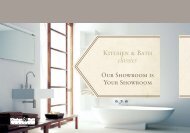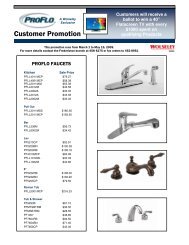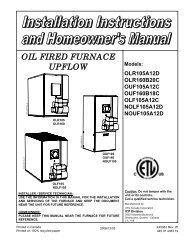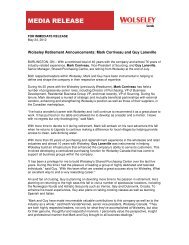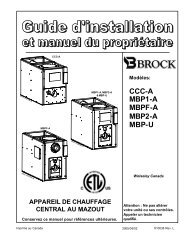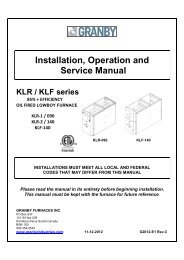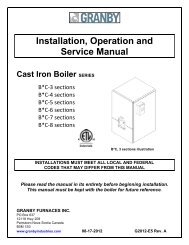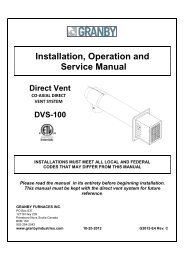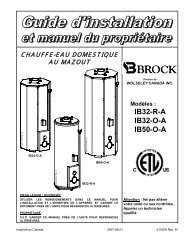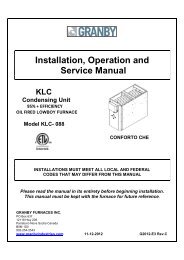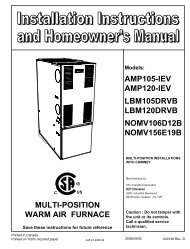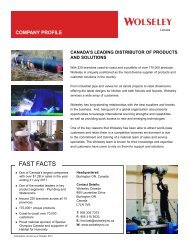OLR350H28B - Wolseley Canada Inc
OLR350H28B - Wolseley Canada Inc
OLR350H28B - Wolseley Canada Inc
Create successful ePaper yourself
Turn your PDF publications into a flip-book with our unique Google optimized e-Paper software.
Pre-installation inspection of vent system<br />
Before installing this furnace, it is highly recommended that any<br />
existing vent system be completely inspected.<br />
This inspection should include the following:<br />
a. Inspection for any deterioration in the chimney or vent. If<br />
deterioration is discovered, the chimney must be repaired or<br />
the vent must be replaced;<br />
b. Inspection to ascertain that the vent system is clear and free of<br />
obstructions. Any blockages must be removed before installing<br />
this furnace;<br />
c. Cleaning the chimney or vent if previously used for venting a<br />
solid fuel burning appliance or fireplace;<br />
d. Confirming that all unused chimney or vent connections are<br />
properly sealed;<br />
e. Verification that the chimney is properly lined and sized per the<br />
applicable codes (refer to list of codes on page 4).<br />
Masonry Chimney<br />
This furnace can be vented into an existing masonry chimney.<br />
However, it must not be vented into a chimney servicing a solid fuelburning<br />
appliance. Before venting this furnace into a chimney, the<br />
chimney must be checked for deterioration and repaired if<br />
necessary. The chimney must be properly lined and sized per local<br />
or national codes.<br />
If the furnace is vented into a common chimney, the chimney must<br />
be of sufficient area to accommodate the total flue products of all<br />
appliances vented into the chimney.<br />
The following requirements are provided to ensure a safe venting<br />
system:<br />
a. Ensure that the chimney flue is clear of any dirt or debris;<br />
b. Ensure that the chimney is not servicing an open fireplace;<br />
c. Never reduce the pipe size below the outlet size of the furnace;<br />
d. All pipes should be supported using the proper clamps and/or<br />
straps. These supports should be at least every 1.2 m (4').<br />
e. All horizontal runs of pipe should have at least a 6.4 mm (1/4”)<br />
per (1') of upward slope;<br />
f. All runs of pipe should be as short as possible with as few turns<br />
as possible;<br />
g. Seams should be tightly joined and checked for leaks;<br />
h. The flue pipe must not extend into the chimney but be flush<br />
with the inside wall;<br />
i. The chimney must extend 0.9 m (3') above the highest point<br />
where it passes through a roof of a building and at least 0.6 m<br />
(2') higher than any portion of a building within a horizontal<br />
distance of 3.0 m(10'). It shall also be extended at least 1.5 m<br />
(5') above the highest connected equipment flue collar;<br />
j. Check local codes for any variances.<br />
Factory built chimneys<br />
This furnace may be used with an approved factory built chimney.<br />
Refer to chimney manufacturer’s instructions for proper installation.<br />
1.5) COMBUSTION AIR SUPPLY<br />
WARNING<br />
Poisonous carbon monoxide gas hazard.<br />
Comply with ANSI/NFPA (in the U.S.A.) or CSA (in<br />
<strong>Canada</strong>) standards for the installation of Oil<br />
Burning Equipment and applicable provisions of<br />
local building codes to provide combustion and<br />
ventilation air.<br />
Failure to provide adequate combustion and<br />
ventilation air can result in injury or death.<br />
1.5.1) General<br />
Oil furnaces must have an adequate supply of combustion air. It is<br />
common practice to assume that older homes have sufficient<br />
infiltration to accommodate the combustion air requirements for the<br />
furnace. However, home improvements such as new windows, doors,<br />
and weather stripping have drastically reduced the volume of air<br />
infiltration into the home.<br />
Home air exhausters are common. Bathroom and kitchen fans, power<br />
vented clothes dryers, and water heaters all tend to create negative<br />
pressure in the home. Should this occur, the chimney becomes less<br />
and less effective and can easily downdraft.<br />
Heat recovery ventilation (HRV) systems are gaining in popularity.<br />
HRVs are not designed to supply combustion air. If not properly<br />
balanced, a serious negative pressure condition could develop in the<br />
dwelling.<br />
1.5.2) Contaminated Combustion Air<br />
Installations in certain areas or types of structures will have increased<br />
exposure to chemicals or halogens which may harm the furnace.<br />
These instances will require that only outside air be used for<br />
combustion.<br />
The following areas or types of structures may contain or be exposed<br />
to the substances listed below. The installation must be carefully<br />
evaluated, as it may be necessary to provide outside air for<br />
combustion.<br />
a. Commercial buildings;<br />
b. Buildings with indoor pools;<br />
c. Furnaces installed near chemical storage areas.<br />
Exposure to the following substances:<br />
a. Permanent wave chemicals for hair;<br />
b. Chlorinated waxes and cleaners;<br />
c. Chlorine based swimming pool chemicals;<br />
d. Water softening chemicals;<br />
e. De-icing salts or chemicals;<br />
f. Carbon tetrachloride;<br />
g. Halogen type refrigerants;<br />
h. Cleaning solvents (such as perchloroethylene);<br />
i. Printing inks, paint removers, varnishes, etc.;<br />
j. Hydrochloric acid;<br />
k. Solvent based cements and glues;<br />
l. Antistatic fabric softeners for clothes dryers;<br />
m. Acid based masonry cleaning materials.<br />
6



